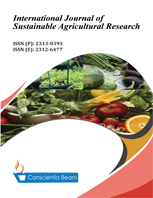Effects of basal fertilizer type and application rates on growth and yield of grain amaranth in Kwekwe, Zimbabwe
DOI:
https://doi.org/10.18488/ijsar.v12i1.4089Abstract
This research examines the effects of basal fertilizer type and application rates on the growth and yield of grain amaranth in Kwekwe, Zimbabwe. Grain amaranth is a neglected crop of tremendous nutritional and agronomic qualities. However, knowledge on basal fertilizer rates and types to use in grain amaranth production is limited in Zimbabwe; therefore, this experiment was carried out to investigate this limitation at Midlands State University (MSU), Kwekwe farm, from December 2022 to April 2023 using a 3x5 factorial design, consisting of 3 basal fertilizer types and 5 application rates. The basal fertilizer types were compound C (6:24:20), compound D (7:14:7) and compound L (6:15:12). The application rates were 0 (control), 90 kg/ha, 180 kg/ha, 270 kg/ha, and 360 kg/ha. Data was collected on plant height, stem girth, Leaf Area Index (LAI), biomass yield, grain yield from the main head (panicle weight), grain yield produced by side suckers, 1000 seed weight, and overall grain yield. There was no significant difference (p>0.05) in amaranth biomass, plant height, and stem girth due to the effects of basal fertilizer type. Compound C at a rate 360 kg/ha, produced the highest grain yield of 2.671 tons /ha, while the 0 kg/ha control produced the lowest grain yield of 0.659 t/ha. Treatment interaction effects were significant only for total grain yield, grain yield of the main panicle, suckers, and 1000 seed weight. Compound C produced the highest results on most parameters, significantly outperforming compounds D and L. However, at higher rates of basal fertilizer application, all 3 compound fertilizers turned out to be equally good. In conclusion, we recommended that, for efficient production of grain amaranth, compound C should be used at 270 kg/ha.

